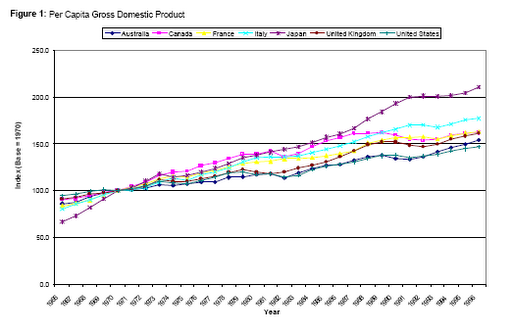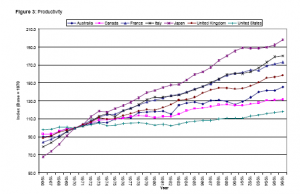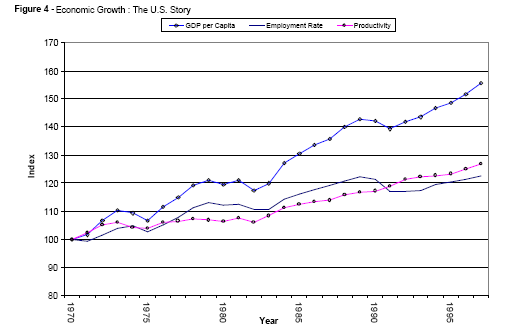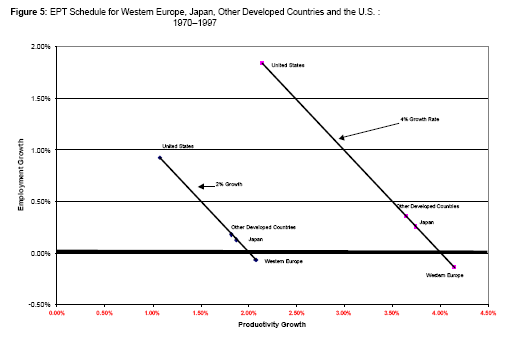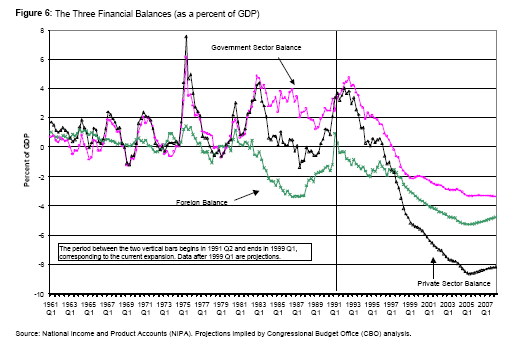Where to begin? Since the days of George Washington’s administration, national budget deficits and increased public debt have been the rule on all but about six very short occasions. And the US has generally prospered. Why? Far from being a burden, the deficits, and the corresponding government bonds, constitute the foundation of private financial wealth in any nation that creates its own sovereign currency for use by its citizens. Debt owed by the government yields net income to the private sector, unlike all purely private debts, which merely transfer income from one part of the private sector to another. In basic national accounting terms, government deficits equal non-government savings surpluses.
Another important other angle that is often overlooked is that private holdings of government bonds also constitute an income source – that is, the government interest payments on its outstanding debt constitute another avenue for stimulus. So when the Government retires debt it reduces private incomes, just as when it runs budget surpluses, it constrains private sector demand directly by reducing private income and access to adequate currency. Just ask any pensioner if he/she is happy when their income stream from annuities has declined.
Take away that debt, and you take away income. It is no coincidence that the budget surpluses of the Clinton years (wrongly trumpeted as a great fiscal triumph by President Obama) subsequently led to recessions: government budget surpluses ultimately restrict private sector demand and income growth and force greater reliance on PRIVATE debt. Does anybody think it is a coincidence that two of the longest and largest periods of budget surpluses in America history – the periods of 1997-2000 and 1927-1930 – were followed by calamitous economic collapses?
There are ample analyses which explain how government surpluses drain aggregate demand (here, and here). Suffice to say, a government budget surplus has two negative effects for the private sector: the stock of financial assets (money or bonds) held by the private sector, which represents its wealth, falls; and private disposable income also falls as tax demands exceed income. And, as Stephanie Kelton has noted, the case of Japan illustrates that despite a debt-to-GDP ratio in excess of 200%, the Bank of Japan never lost the ability to set the key overnight interest rate, which has remained below 1% for about a decade. And, the debt didn’t drive long-term rates higher either.
Furthermore, now that we’re off the gold standard, Chinese and other Treasury buyers do not “fund” anything for us, contrary to the completely false and misguided scare stories that deficit hawks and, and now Obama, implicitly endorse. (See here for an explanation). Legions of economists, investment advisors, Wall Street practitioners and policy makers continue to peddle such gold-standard thinking to their citizens nationwide. To paraphrase Churchill, “It is as though a vast Gold Standard curtain has descended across the entire body of public thinking.”
Let’s consider a real world example to demonstrate the President’s conceptual confusion on government deficits. We’re in a recession. Our American citizen who was working in a pie shop has lost his job even though his productivity was just as high during the boom years. The problem is that as the recession intensified, pie demand fell as did consumer demand in general. For a variety of reasons, households perceive their wealth holdings are not going to appreciate as quickly as they did in prior periods, so they are saving more money out of their income flows.
The pie guy wants to exercise his freedom to work hard for money. So too do 152 million other people. But there are jobs available for only 138 million of them given current business perceptions of money profit prospects from production now and in the future. The pie guy is stuck with over 15 million other people who would like to exercise their freedom to work hard for money. Over 6 million of those people have been trying to exercise that freedom for over half a year, with no luck. They are dumpster diving for leftover pie scraps.
In desperation, the pie guy has gone back to the pie shop to offer his services for a lower money wage, but unit pie demand is still down, even though the owner has cut pie prices. However, the pie owner, facing lower prices per pie, decides to hire the pie guy back at a lower wage and fires one of his other workers to scratch his way to a little higher profit. Are we all any better off? I suppose pies are cheaper, but then so too are incomes earned by pie makers lower.
In that situation, someone else has to take up the spending slack. Fortunately, we live in an economic system in which a government can freely spend and fill the gap left by the private sector. It has the unique capacity to spend without the constraint of a private firm on productive job creation, thereby increasing output, not just redistributing it. Just giving the pie firm a payroll tax cut on new hires is not going to generate more jobs. Rather giving it to all employees will lead to more pie sales. And the government can do that. Rather than decrying the government deficits, then, the President should be celebrating them as a form of economic salvation.
The problem obviously isn’t about money which a government can always create. The ultimate irony is that in order to somehow ‘save’ public funds for the future, as the President appears to be advocating, what we do is cut back on expenditures today, which does nothing but set our economy back and cause the growth of output and employment to decline. Worse yet, the great irony is that the first thing governments generally cut back on is education- the one thing the mainstream agrees should be done that actually helps our children 50 years down the road. Education cutbacks – as any Californian can tell you – are something that does hurt us, as well as harming our children AND our grandchildren down the road. This is the true “intergenerational theft”, not “runway” government spending.
Like many other people who embrace the nostrums of the Concord Coalition, the President continues to view government spending through a failed household budget analogy:
“There are certain core principles our families and businesses follow when they sit down to do their own budgets. They accept that they can’t get everything they want and focus on what they really need. They make tough decisions and sacrifice for their kids. They don’t spend what they don’t have, and they make do with what they’ve got.”
Yes, it’s true: If households spend more than their income now, they have to borrow. To pay the loan back they have to ensure that they can dedicate adequate income in the future, either by increasing incomes somehow or diverting existing income from consumption. If a household borrows too much, it will face major corrections in its balance of income and expenditure and consequently may have to seriously forgo spending later.
That is the logic that the users of the currency have to consider every day. They have to finance every $ they spend and so planning is required to ensure they don’t blow out their personal balance sheets. If all households attempt to net save by spending less than they are earning, and businesses attempt to net save (reinvesting less than their retained earnings), then private sector incomes and real output will decline absent an increase in government spending.
But it’s not the same for a government, as the President wrongly suggests, as the government is the creator of a currency. They can spend now. They can also spend later as well as service and pay back the debt without compromising anything. And a government, unlike a household or a private business, can choose to exact greater tax revenues by imposing new taxes or raising tax rates.
Notwithstanding the obvious reality that sovereign governments have no solvency risk because they create their own currency, most financial commentators (and the President’s own advisors) still waste their time talking about sovereign default risks and the President implicitly legitimizes this sort of talk when he talks about the need for government to embrace budgeting like a household does. This is what we presume he has in mind when he discusses the long term dangers of government deficits. Firms, households, and even state and local governments require income or borrowings in order to spend. But the federal government’s spending is not constrained by revenues or borrowing. It is constrained only by what our population chooses as national goals.
Suffice to say, we would all rather live in a world where profit prospects are so abundant that business investment spending is high enough to insure full employment given household preferences to save out of income flows. But historical and current experience suggests that is a rare configuration indeed. Ideally, that would be the business sector investing more than it retains in earnings. But in recent decades, such appears to only be the case during asset bubbles, and we know how that story ends. Alternatively, the foreign sector could deficit spend – the US could run a trade surplus. But the reality is US firms have chosen to reinvest in low cost production centers abroad (or would prefer to use free cash flow to engage in short run shareholder value maximization through various financial engineering efforts, including M&A) so the US based production structure no longer matches foreign demand very well. Ironically that leaves government fiscal deficit spending as the sole remaining mechanism to insure the freedom of its citizens to work hard for money.
The President, unfortunately, has yet to put the pieces of the puzzle together. He also fails to understand the idea that a government like the United States – i.e. one that issues a non-convertible sovereign currency (i.e. one the government doesn’t promise to convert into gold or other currencies at a fixed price) – can meet any and all outstanding financial obligations, provided the debts are denominated in its national currency. In this regard, the size of the national debt is irrelevant. This myth, and this myth alone, underpins arguments by orthodox economists against government activism in macroeconomic policy. The President does his Administration and the country no service by continuing to jump on this mythical bandwagon. Myth may constitute good grounds for literature, but is a horrible foundation for sound economic policy.


